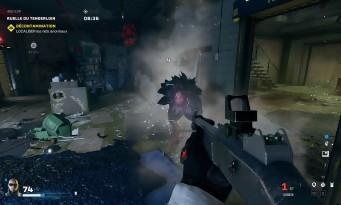 The opening cinematic shows us the Statue of Liberty and the surrounding tourist area being overrun by a destructive alien parasite. This photo-realistic scene is also rather successful. Despite its status as a multiplayer game, Extraction is not content with a pretty pre-calculated intro sequence, but distills additional small sketches as you progress (the first time you access the search menu, the first time you launch a solo game, the first time you release an agent….). This rather pleasant point of detail still leaves a little bitter taste, because it makes us regret all the more the absence of a real single-player campaign. The scenario and the gameplay would indeed have been perfectly suited to a "linear" adventure. The latter would also have made it possible to reinforce the personality of the game, which necessarily lacks it because of the Tom Clancy brand. This tends to standardize things. Honestly, we would have dealt with a Ghost Recon: Extraction, a The Division: Extraction, or even a Splinter Cell: Extraction that it would have changed absolutely nothing in terms of atmosphere. Come on, let's mourn (for the moment?) a real single player mode, and let's focus on the qualities of the product, which turns out to be much better than what we expected a priori. For starters, the content seems important enough to us despite what a quick first glance might suggest. There are indeed only four different environments: New York, San Francisco, Alaska and Truth or Consequences (a city in New Mexico that actually bears this name). But each of these regions is divided into three distinct areas, such as museum, hotel, bar, casino or even police station. This therefore gives us a very honorable total of twelve maps, while the number of agents to be improved amounts to eighteen.
The opening cinematic shows us the Statue of Liberty and the surrounding tourist area being overrun by a destructive alien parasite. This photo-realistic scene is also rather successful. Despite its status as a multiplayer game, Extraction is not content with a pretty pre-calculated intro sequence, but distills additional small sketches as you progress (the first time you access the search menu, the first time you launch a solo game, the first time you release an agent….). This rather pleasant point of detail still leaves a little bitter taste, because it makes us regret all the more the absence of a real single-player campaign. The scenario and the gameplay would indeed have been perfectly suited to a "linear" adventure. The latter would also have made it possible to reinforce the personality of the game, which necessarily lacks it because of the Tom Clancy brand. This tends to standardize things. Honestly, we would have dealt with a Ghost Recon: Extraction, a The Division: Extraction, or even a Splinter Cell: Extraction that it would have changed absolutely nothing in terms of atmosphere. Come on, let's mourn (for the moment?) a real single player mode, and let's focus on the qualities of the product, which turns out to be much better than what we expected a priori. For starters, the content seems important enough to us despite what a quick first glance might suggest. There are indeed only four different environments: New York, San Francisco, Alaska and Truth or Consequences (a city in New Mexico that actually bears this name). But each of these regions is divided into three distinct areas, such as museum, hotel, bar, casino or even police station. This therefore gives us a very honorable total of twelve maps, while the number of agents to be improved amounts to eighteen.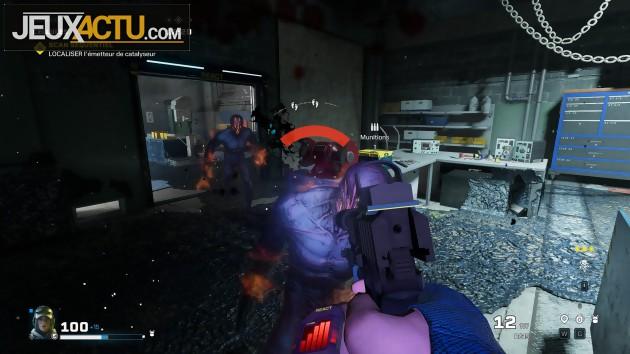
EARTH EXTRACTION
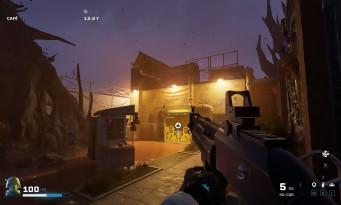 The maps are divided into three sub-areas separated by airlocks, and each of these sub-areas offers us a particular objective. The challenges are increasingly difficult, and at each stage the choice is given to us between moving on to the next section and earning more rewards (at the risk of experiencing failure) or requesting an immediate extraction to immediately validate the experience gained. and be sure not to lose an agent. Remember in passing that the missions are preferably traveled by three, cross-platform compatible matchmaking can possibly be responsible for finding partners. Playing alone is still possible, but some objectives then become really difficult to complete. It must be said that the aliens have quite special skills. It is also one of the qualities of the game not to have imposed on us once again terrorists or zombies. One of the mechanics allowed by this universe of science fiction is emergence. It is a blackish parasitic substance which spreads over the decorations. It is spawned by alien nests and by the Archaeans themselves when they die.
The maps are divided into three sub-areas separated by airlocks, and each of these sub-areas offers us a particular objective. The challenges are increasingly difficult, and at each stage the choice is given to us between moving on to the next section and earning more rewards (at the risk of experiencing failure) or requesting an immediate extraction to immediately validate the experience gained. and be sure not to lose an agent. Remember in passing that the missions are preferably traveled by three, cross-platform compatible matchmaking can possibly be responsible for finding partners. Playing alone is still possible, but some objectives then become really difficult to complete. It must be said that the aliens have quite special skills. It is also one of the qualities of the game not to have imposed on us once again terrorists or zombies. One of the mechanics allowed by this universe of science fiction is emergence. It is a blackish parasitic substance which spreads over the decorations. It is spawned by alien nests and by the Archaeans themselves when they die.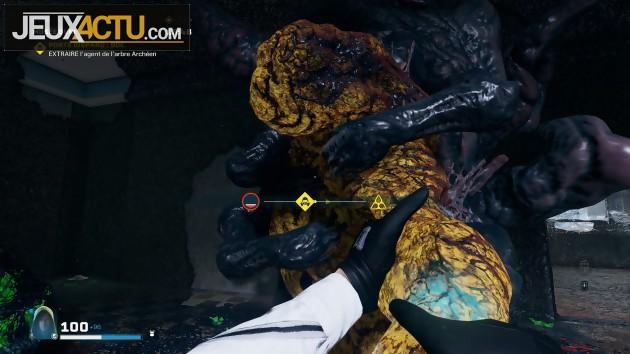
Beyond its very nice filthy appearance, this organic matter slows down the walking speed of human agents. It is possible to dissipate some of it by shooting it, but in this case, say goodbye to stealth! Besides, the Archaeans that we have to face here are quite passive by default. Some remain motionless, while others move slowly around the place. But if they ever detect you, they'll start howling, which will alert other aliens and wake up nearby nests. These cocoons will then start continuously generating enemies until you destroy them. A stealth approach is therefore recommended, whether it is to carry out eliminations behind the backs of the Archaeans or to destroy the nests preventively. This infiltration component is all the more successful as it goes hand in hand with a certain amount of tactics, as required by the Rainbow Six license. We also find the destructibility of the sets from Siege. Killing an enemy through a wall, destroying a wall to free up a passage or, on the contrary, reinforcing a partition in order to slow down the progress of opponents are all possible actions. It is also advisable to lean to the sides, shoot at the weak points of the enemies and of course to use the singular abilities of the different agents.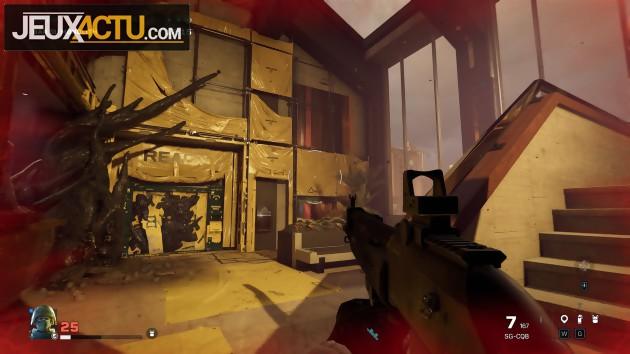
ALL RISK AGENTS
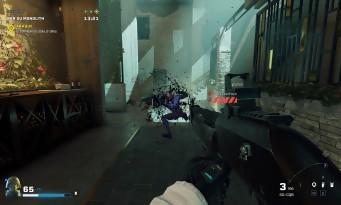 Each of the eighteen agents plays differently from the others due to their equipment and, above all, their main ability. Jäger deploys automatic turrets, Rook provides armor plates, Pulse uses a heart sensor to detect enemies through obstacles, Ela launches stun mines, Doc has a sim gun to heal himself and allies, Alibi throws decoys, Lion detects moving enemies, Vigil can become undetectable for a few moments, etc. You'll easily find an agent that matches your preferred way of playing, but it's important to get them all up to speed. The progression system allows you to unlock additional weapons, but also to improve skills and certain essential characteristics (speed, power, protection, etc.). In addition, if you ever fail during a mission while playing as your favorite agent, it will be imperative to use another soldier to free your favorite. Indeed, agents do not die when their life drops to zero. They are automatically covered in stasis moss which keeps them alive. This allows you to free them during the next game taking place in the same area. One of the three sub-zone objectives will then be to free the agent, trapped in an Archaean tree. A sort of mini-game will ask you to deplete the tree's energy by destroying its anchor points at the right time, while pulling the soldier out of his vegetable prison. Not only does this phase turn out to be rather pleasant, but it also has the merit of motivating us to play more and more.
Each of the eighteen agents plays differently from the others due to their equipment and, above all, their main ability. Jäger deploys automatic turrets, Rook provides armor plates, Pulse uses a heart sensor to detect enemies through obstacles, Ela launches stun mines, Doc has a sim gun to heal himself and allies, Alibi throws decoys, Lion detects moving enemies, Vigil can become undetectable for a few moments, etc. You'll easily find an agent that matches your preferred way of playing, but it's important to get them all up to speed. The progression system allows you to unlock additional weapons, but also to improve skills and certain essential characteristics (speed, power, protection, etc.). In addition, if you ever fail during a mission while playing as your favorite agent, it will be imperative to use another soldier to free your favorite. Indeed, agents do not die when their life drops to zero. They are automatically covered in stasis moss which keeps them alive. This allows you to free them during the next game taking place in the same area. One of the three sub-zone objectives will then be to free the agent, trapped in an Archaean tree. A sort of mini-game will ask you to deplete the tree's energy by destroying its anchor points at the right time, while pulling the soldier out of his vegetable prison. Not only does this phase turn out to be rather pleasant, but it also has the merit of motivating us to play more and more.
SERVICE INCLUDED
 Multi game requires, Extraction is as much service as game. It seems obvious that the developers will do everything to ensure maximum longevity, as they were able to do with Siege. But then the question of weariness arises! Playing the same maps over and over for months could lead to some boredom. Fortunately, this Rainbow Six immediately offers random objectives varied enough to maintain the interest of the player. So in each sub-zone you will have to for example destroy abnormal nests, protect explosive charges, place explosives, capture a series of locations, activate stations in a certain order, eliminate an elite target, escort a VIP, eliminate stealth a target, placing trackers on nests or, as mentioned above, freeing a previously captured agent. The game also features a mutation system, which changes the behavior of aliens. The latter, for example, begin to leave traces of emergence behind them when they move. The difficulty system also increases both the risks and the rewards. Finally, mid-game and end-game modes are available from launch, and free of charge, to renew the experience and prolong player interest.
Multi game requires, Extraction is as much service as game. It seems obvious that the developers will do everything to ensure maximum longevity, as they were able to do with Siege. But then the question of weariness arises! Playing the same maps over and over for months could lead to some boredom. Fortunately, this Rainbow Six immediately offers random objectives varied enough to maintain the interest of the player. So in each sub-zone you will have to for example destroy abnormal nests, protect explosive charges, place explosives, capture a series of locations, activate stations in a certain order, eliminate an elite target, escort a VIP, eliminate stealth a target, placing trackers on nests or, as mentioned above, freeing a previously captured agent. The game also features a mutation system, which changes the behavior of aliens. The latter, for example, begin to leave traces of emergence behind them when they move. The difficulty system also increases both the risks and the rewards. Finally, mid-game and end-game modes are available from launch, and free of charge, to renew the experience and prolong player interest.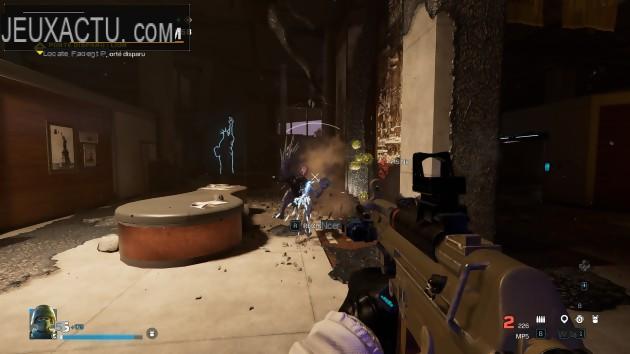
The Ailments are weekly game modes, the Veteran mode imposing for example a total absence of interface on the screen, limited ammunition and an activated friendly fire. Crisis Events are limited-time missions offering additional content (new thematic mode, new agent, new special enemy, etc.). Finally, the Maelstrom Protocol can be considered the "endgame" mode par excellence. Also structured around a weekly rotation, it is made of a restricted selection of agents, nine sub-zones to explore instead of three, and exclusive cosmetic rewards. In addition, the exemplary follow-up to which Rainbow Six: Siege was entitled necessarily encourages confidence. Besides, the experience acquired on Siege is also felt in the general finish of Extraction, which turns out to be quite good. We can certainly observe here and there the corpse of an enemy crossing the sets, but Ubisoft has accustomed us to much worse in the past…


























